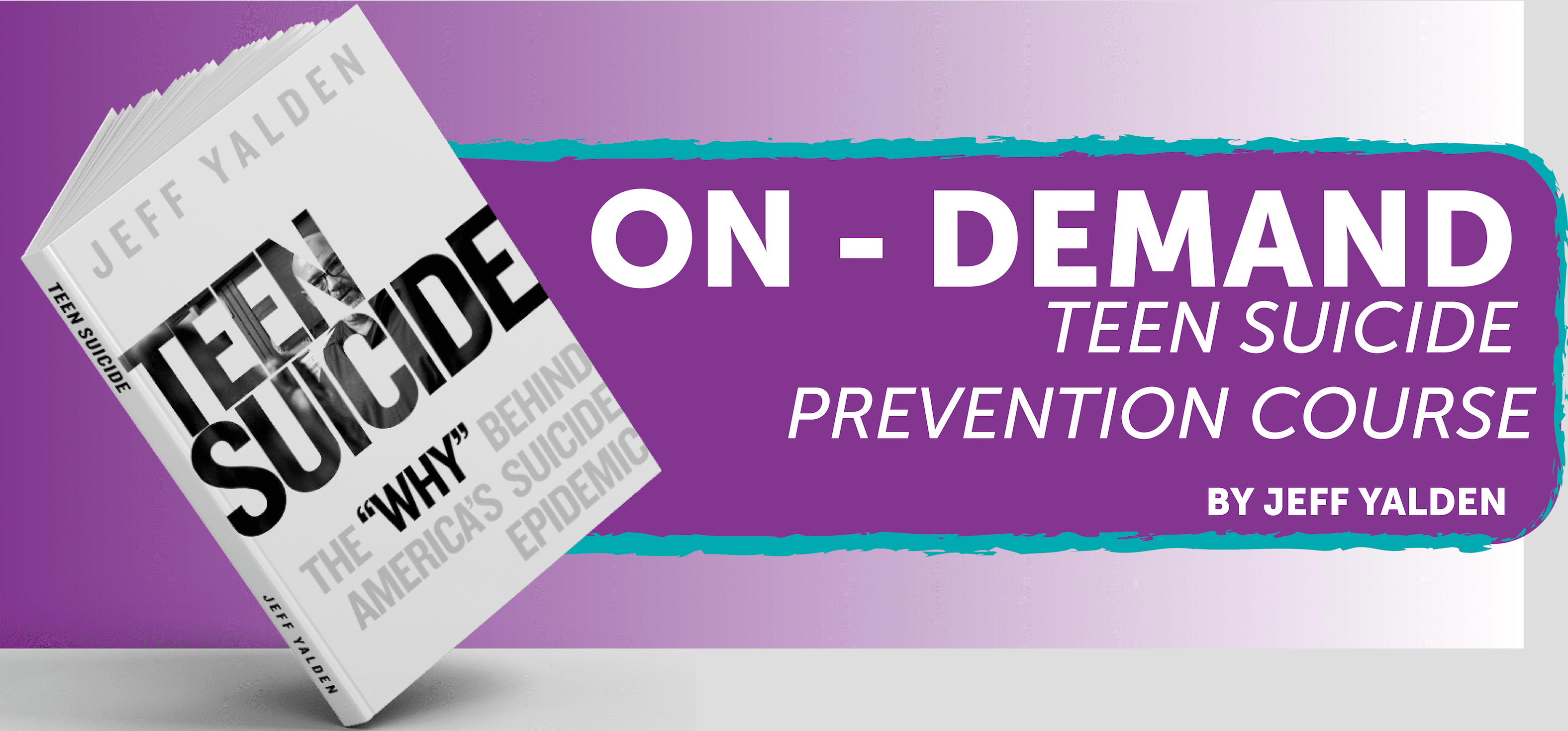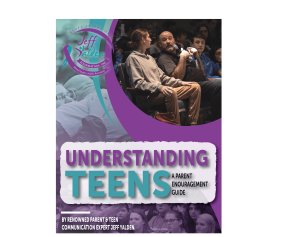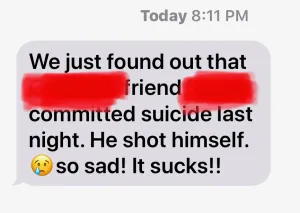“Jeff is an amazing speaker and his message is powerful. I heard him for the first time in Atchison,KS after our community suffered from some very tragic losses. Jeff was amazing and helped with the healing process. My high school son heard Jeff speak and his comment to me was “that was powerful mom.” I brought Jeff to my district this past fall. Again, his message was powerful and he touched the lives of many. Jeff you are amazing!!! Keep fighting the fight!” – Julie Crum, Principal
Preventing and Addressing Teen Suicidal Ideation in Schools
 Teen Suicide Prevention Course for School Communities
Teen suicide in schools is common talk today, or many of our schools are feeling the need to start talking about it. Full applause to every administrator,
Teen Suicide Prevention Course for School Communities
Teen suicide in schools is common talk today, or many of our schools are feeling the need to start talking about it. Full applause to every administrator,  teacher, coach, student, and parent that supports this and is willing to address the topic of teen mental health. Bravo!
Let’s get acquainted with a few things regarding teen suicide and our schools. It’s really important that we all get educated and know what to do when the conversation happens. Even before the conversation starts, we need to notice the red flags that will lead us to have the conversation. Listen, nothing to be worried about. Nothing to want to shy away from.
Give yourself permission to feel that in this conversation you can handle it and say the right things. You’re not a mental health therapist and your job is not to fix it in the here and the now moment, but you being present, compassionate, and giving your attention to the situation is saving the person’s life and giving them hope, permission, and time. That is all you need to think of as your job. You are in the relationship with connecting and being there. This person trusts you and shortly by your actions will know how much you care. You’ve done a lot and you don’t even realize it.
The warning signs associated with teen suicide should be learned by every adult and student. This should be common place in today’s schools. Just knowing the warning signs alone you can say something to a school counselor or school administrator. Furthermore, teachers and students should be trained in active listening skills because they’re the front lines of intervening when they hear a student or friends “cries for help.”
teacher, coach, student, and parent that supports this and is willing to address the topic of teen mental health. Bravo!
Let’s get acquainted with a few things regarding teen suicide and our schools. It’s really important that we all get educated and know what to do when the conversation happens. Even before the conversation starts, we need to notice the red flags that will lead us to have the conversation. Listen, nothing to be worried about. Nothing to want to shy away from.
Give yourself permission to feel that in this conversation you can handle it and say the right things. You’re not a mental health therapist and your job is not to fix it in the here and the now moment, but you being present, compassionate, and giving your attention to the situation is saving the person’s life and giving them hope, permission, and time. That is all you need to think of as your job. You are in the relationship with connecting and being there. This person trusts you and shortly by your actions will know how much you care. You’ve done a lot and you don’t even realize it.
The warning signs associated with teen suicide should be learned by every adult and student. This should be common place in today’s schools. Just knowing the warning signs alone you can say something to a school counselor or school administrator. Furthermore, teachers and students should be trained in active listening skills because they’re the front lines of intervening when they hear a student or friends “cries for help.”
 Jeff’s new booklet for Parents and Teens
The more aware we are of the signs and symptoms of teen suicide the greater possibility in getting the person in need the help sooner rather than later. It only takes a minute to make a forever decision and the sooner we can intervene the sooner the individual can be given hope to a hopeless situation.
Outside Resources:
All teachers and school personnel should be given the outside resources available to students and families who may be considering suicide or in need of mental health care. This should also be on all schools websites so the community can easily access it anytime. Know the various resources available and quickly be able to access them. Having this information on hand and readily accessible shows genuine concern for your students and also offers a sense of hope in facing life’s challenges.
School Policy:
With the outside resources every school should also have an understanding of the school policy and what to do in different situations. Know the policies and procedures and have them written down. Know what to do and how to respond appropriately to suicidal threats in school and out of school. This knowledge will not only help students and staff members, but it will also possibly avoid lawsuits.
Jeff’s new booklet for Parents and Teens
The more aware we are of the signs and symptoms of teen suicide the greater possibility in getting the person in need the help sooner rather than later. It only takes a minute to make a forever decision and the sooner we can intervene the sooner the individual can be given hope to a hopeless situation.
Outside Resources:
All teachers and school personnel should be given the outside resources available to students and families who may be considering suicide or in need of mental health care. This should also be on all schools websites so the community can easily access it anytime. Know the various resources available and quickly be able to access them. Having this information on hand and readily accessible shows genuine concern for your students and also offers a sense of hope in facing life’s challenges.
School Policy:
With the outside resources every school should also have an understanding of the school policy and what to do in different situations. Know the policies and procedures and have them written down. Know what to do and how to respond appropriately to suicidal threats in school and out of school. This knowledge will not only help students and staff members, but it will also possibly avoid lawsuits.
 Renowned youth mental health and suicide prevention speaker has a theory about teen suicide
Renowned youth mental health and suicide prevention speaker has a theory about teen suicide
Teen Suicide: Know the Warning Signs
All teachers and staff members should be aware of possible warning signs of suicide. Take all signs seriously. If you see something you should say something. If you know something you should do something. You generally have four different types clues that something is wrong:- Direct Verbal Clues
- Indirect Verbal Clues
- Behavioral Clues
- Situational Clues
- Talking about suicide, hurting themselves, death, or dying
- Seeking access to firearms or pills
- Withdrawing from friends, family, and society
- Having severe mood swings
- Feeling hopeless or trapped
- Increased use of alcohol or drugs
- Sleeping all the time or having issues with sleep
- Uncontrolled rage or agitation
- Self-destructive and risky behavior
- Giving away personal belongings
- Telling people goodbye for seemingly no reason
 Don’t let this happen to one of your students.
Don’t let this happen to one of your students.
If a teenager suffers from a mental illness, has a family history of suicide, history of trauma or abuse, broken family, feeling alone or a disappointment, chronic pain, social isolation, or a traumatic life event such as loss of a loved one, rejection by peers or no social support may be at an increased risk for suicide. Remember that people at any age can experience suicidal thoughts—suicide is the second leading cause of death among teenagers.
Other Factors to Consider
- Gender: Men commit suicide successfully 4.5 times more often than women, but women attempt suicide 2-4 times more than men.
- Ethnicity: African-Americans, Hispanic-Americans, and Asian-Americans have lower rates than Euro-Americans.
- However, Native Americans have rates 1.6-4.2 times the national average.
- Sexual orientation: Homosexual teens are three times more likely to attempts suicide than heterosexual teens.
- Previous suicide attempts: Of all completed suicides, 10-40% have previously attempted suicide.
Ways to Intervene:
Here is where knowing the policies and procedures of your school district will help you immensely. Follow the guidelines accordingly and swiftly. Be prepared to drop everything to take time to deal with the situation. Take every complaint and feeling the child expresses seriously. Do not try to minimize the problem by telling him/her everything they have to live for. This will only increase feelings of guilt and hopelessness. Be calm, supportive, and nonjudgmental. Listen actively and encourage self-disclosure. It is okay to acknowledge the reality of suicide as a choice, but do not “normalize” suicide as a choice. Assure the student that he or she is doing the right thing by confiding in you. Do not express discomfort with the situation. Your willingness to discuss it will show the person that you do not condemn him or her for having such feelings. Stay with the student. Never leave him/her alone until further action has been taken. You have done everything you can by just being here, listening, and being non-judgemental. If you are talking to someone via phone, do not hang up; get someone else to call for help on another line. Recognize that talking about suicide will not plant the idea! In reality, talking about suicide reduces their anxiety and finally they feel they’ve been able to open up and share. Listen and ask questions. Show that you are paying attention and that you care. Ask direct, straightforward questions. (“Are you thinking of suicide?”) Be aware that students will usually respond “no.” This is not your place to challenge them or wonder if they’re being truthful. Remember, you are the person that got them talking and the next step will be with the mental health professionals or third party psychiatric care and evaluation. Without you intervening here they may not get the help they need. Ask questions to assess the severity of the situation
Ask questions to assess the severity of the situation
- What has happened to make life so difficult?
- What has been keeping you alive so far?
- Are you thinking of suicide?
- Do you have a suicide plan?
- Do you use alcohol or drugs?
- When you think about yourself and the future, what do you visualize?
- Is the means available to you? Remove the means if possible.
- What do you think the odds are that you will kill yourself?
 Don’t ask the questions back to back. Engage in conversation and do more listening than talking. The more you listen the more the individual will know you care. In this moment that you have they want to know if you care and if they can trust you. You’re doing everything. More than you think.
Don’t ask the questions back to back. Engage in conversation and do more listening than talking. The more you listen the more the individual will know you care. In this moment that you have they want to know if you care and if they can trust you. You’re doing everything. More than you think.
Consider the SLAP method of determining the risk of the student’s plan:
Again, the severity of the risk isn’t your determination to make. Either way, the situation needs to be addressed with the parents, the school counselors, or a third party mental health professional from this conversation. That includes you calling 911, school administration, school counselor, parents, family members, etc. It’s important that you have this information though because it needs to be documented. S = How (S) pecific are the details of the plan? L = What is the (L) evel of lethality of the plan? (Gun vs. aspirin) A = What is the (A) vailability of the proposed method? P = What is the (P) roximity to helping resources? Be positive and supportive in your approach. Help the individual student see that what they’re feeling in this moment is temporary and that the crisis will pass. Just get the individual to breathe. Share about the finality of suicide and that it’s permanent and the situation they’re dealing with or feeling is temporary. Just remember, you are not a trained therapist. In the here and the now, your job is to understand and be compassionate, empathetic, and lead the student to the right person in the moment of crisis.
Often an individual contemplating suicide is unaware of the different support groups such as (e.g., counselors, family, friends) that are available. Or, they feel they can’t talk to them or they don’t know how to talk to them. Keep mention the individual’s family as a source of strength, but if they reject the idea, back away quickly. For teens, the source of pain is usually either the family or the peer group. When you know which it is, you are in a better position to help or refer for help.
Use constructive questions to help separate and define the person’s problems and remove some of their confusion. To help the person understand their situation, use active listening and respond empathically. (“It sounds like you feel…”). Allow them to talk and you listen.
Provide reassurance that help is available, these feelings are treatable, and that suicidal feelings are temporary.
As you’re listening and calm, also know you are in a crisis situation and you need to make crisis management decisions in the moment. Be decisive. Rapid decision making on the part of the intervener is extremely important. If you need someone find out who the individual’s trust and significant adult is and call for help (with their permission).
Share about the finality of suicide and that it’s permanent and the situation they’re dealing with or feeling is temporary. Just remember, you are not a trained therapist. In the here and the now, your job is to understand and be compassionate, empathetic, and lead the student to the right person in the moment of crisis.
Often an individual contemplating suicide is unaware of the different support groups such as (e.g., counselors, family, friends) that are available. Or, they feel they can’t talk to them or they don’t know how to talk to them. Keep mention the individual’s family as a source of strength, but if they reject the idea, back away quickly. For teens, the source of pain is usually either the family or the peer group. When you know which it is, you are in a better position to help or refer for help.
Use constructive questions to help separate and define the person’s problems and remove some of their confusion. To help the person understand their situation, use active listening and respond empathically. (“It sounds like you feel…”). Allow them to talk and you listen.
Provide reassurance that help is available, these feelings are treatable, and that suicidal feelings are temporary.
As you’re listening and calm, also know you are in a crisis situation and you need to make crisis management decisions in the moment. Be decisive. Rapid decision making on the part of the intervener is extremely important. If you need someone find out who the individual’s trust and significant adult is and call for help (with their permission).
 Example: “So, I know you’re really close with your math teacher, Ms. __________. Would you like me to call and see if she is available?”
Example: “So, I know you’re really close with your math teacher, Ms. __________. Would you like me to call and see if she is available?”
The situation needs to move forward
Report the incident to the appropriate school personnel. In this situation what is the policy and procedure from your school? Be able to access it. Contract, Phone Numbers, Chain of Command, etc. (Seek the guidance of a counselor or psychologist as to what is appropriate. Be aware of your school’s policy regarding such situations. Before leaving the student make sure they verbally promise they will be safe and won’t make a forever decision – Commit Suicide. If you can, get the student to sign something that you had written up. Make sure this is the last resort before leaving a student alone in this situation. Notify parents immediately. Consider hospitalization if you sense the urgency of the crisis and you can’t get hold of anyone. Right now, the important thing is to enlist the help of the school counselor or a mental health care professional. Depending on the time of day and the whereabouts of this moment, you have to act and do accordingly.Do not keep the person’s threat a secret, but do respect their privacy.Actions to Avoid
Make no promises. This is a situation where it is never appropriate to promise confidentiality. Do not ignore or lessen the suicidal threat. Avoid sounding shocked at the suicidal thoughts. Do not stress the shock or pain that the suicide may cause their family before you are certain that is not exactly what the student hopes to accomplish. Don’t moralize. Do not argue with a student who may be suicidal. You may not only lose the debate, but also the person. Don’t criticize, ridicule, or infer that the person is crazy. Don’t be concerned by long periods of silence. Allow the student time to think. Do not ignore your own intuitions about a student’s behavior or changes. Do not try to handle the situation alone. Do not attempt in-depth counseling. Be present. Be patient. Listen.Additional Information Regarding Suicide
If a suicide does occur, it is essential that the students be provided with accurate facts about the suicide as soon as possible. This information should be given to all students simultaneously. It is necessary to provide sufficient time for discussion and also support for the students. Be careful here because you need to know what the family/parents are saying. This is also a moment where the school administration may not have had time to brief the school staff so the school staff is with the students and will have to have the conversation. You know how to talk to the students. Be gentle, listen, it’s okay to show your emotions. This is real and the kids want real. The kids will look to you for guidance and support. It’s okay to just say, “I don’t know right now. I’m shocked. I have to process this and breathe. Right now, that’s all we can all do.” Allow them to talk and express their feelings. This is good. Getting them to talk openly and together is the best and safest thing. Keep them in school and together. School is the safest place for everyone to be. Together. Of the people that commit the act of suicide, 90% have showed signs that indicated they needed help. Most have told someone within the previous couple weeks that they were thinking about hurting themselves. In the past 30 years, teen suicide has increased 300%. Among children between the ages of 10-14, suicide has gone up 112%. For every completed suicide, there are between 300 attempts. Remember that suicidal adolescents are a diverse group. Be aware of the ripple effect.Research shows an increase in adolescent suicide following media coverage of a high profile suicide.

